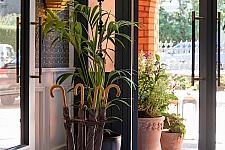Please choose another hotel in Gran Canaria.
Or scroll to the bottom for other locations.
Reasons to visit Gran Canaria
Gran Canaria is the third largest Canary Island and so geographically diverse that it is often referred to as a "Little Continent". The scenery varies from massive snow-capped mountains, rugged ravines and aromatic pine forests in the central area, to lush sub-tropical valleys amidst cliffs and gorges in the north and never-ending desert-like sand dunes and beaches in the south. As a holiday destination it offers something for everyone. Most tourists head for the south of the island where miles of yellow sandy beaches can be found. Here you will find the popular resorts of San Agustin, Playa del Ingles and the famous dunes of Maspalomas. This area also has a good choice of sports and leisure facilities including all sorts of water-sports, tennis, golf, theme parks, casinos, shows and even camel trekking!
The cosmopolitan port city of Las Palmas on the north east coast is the capital of the region. It offers duty-free shopping, numerous restaurants, bars and long sandy beaches. The city also boasts an important historical and cultural heritage, much of which can be found in the district of Vegueta, the oldest quarter of the town, which has been declared a UNESCO World Heritage Site.
Away from the city and the busy resorts of the south coast there is much to discover in the interior of Gran Canaria where rural tourism offers an attractive alternative for the independent traveller. Almost 43% of Gran Canaria is protected, making the island a real paradise for nature lovers. The Regional Government has invested in restoring the Caminos Reales (public footpaths) as a way of attracting walkers to the island. These ancient paths, used in centuries gone by to travel by foot or on horseback, radiate out from the central mountainous region of Cruz De Tejeda to cover a large part of the island. From the south of the island you can drive inland through the spectacular Barranco De Fataga also known as the Valley of a Thousand Palms to the historic little town of San Bartolome de Tirajana in the centre of the island. From here there are several tracks up into the mountains.
At 1949 metres high, Pico de las Nieves, situated in the exact centre of the island, is the highest point on the island. It is a lot colder up here and often misty but on a clear day it is just possible to see some of the neighbouring islands. Below stands the impressive Roque Nublo the most recognisable geological feature on Gran Canaria. 1500 metres above sea level and standing 65 metres tall this great monolith of rock is visible from high points all over the island and was considered to be a sacred site by the Guanches, the original islanders. Down at about 1200 metres lies Artenara, the highest town on Gran Canaria. It's a small town of white houses many of which are carved into the rock. The main attraction is La Ermita de la Cuevita, a tiny cave church and home to the statue of the Virgen de la Cuevita. About 12 km to the west of Artenara stands the natural reserve of Pinar de Tamadaba, one of the most stunning nature reserves in Spain and paradise for all walkers and nature lovers. Another charming old mountain village is Teror famous for the Sanctuary of La Virgen del Pino, the patron saint of the island and where the most important religious celebration on Gran Canaria is held. The 6-8 September sees the village celebrating the Fiesta de la Virgen del Pino, where people from across the island and from the other Canarian islands go on a pilgrimage to Teror.
In the north west of the island at the foot of the Tamadaba pine forest is one of the most beautiful, fertile valleys of the island. Here they produce lemons, oranges, avocados and coffee. Near to the valley is the lovely fishing village of Agaete and its port Puerto de las Nieves, well known for its fish restaurants and where there are frequent ferry services to Tenerife, Lanzarote and Fuerteventura. It is also close to some beautiful and secluded rocky bays and the Balneario de los Berrazales with its thermal springs. Arucas is the main town in the north of Gran Canaria and situated in the middle of an important banana growing area. The town boasts some historic buildings, mostly representing the architectural style of the 19th century and an interesting neo gothic parish church, but it is mostly famous for its rum and it is here that the Canary Islands' biggest sugar cane rum factory is located. The factory also houses an interesting museum where you can learn everything about the history of the factory and the rum production process and perhaps get to sample the product! Also, not to be missed around here is another of Gran Canaria's natural wonders, the huge volcanic crater, Caldera de Bandama just south of Las Palmas; it's worth the trek up here for the views alone.
Come and see the Little Continent for yourself: you won't be disappointed.

















